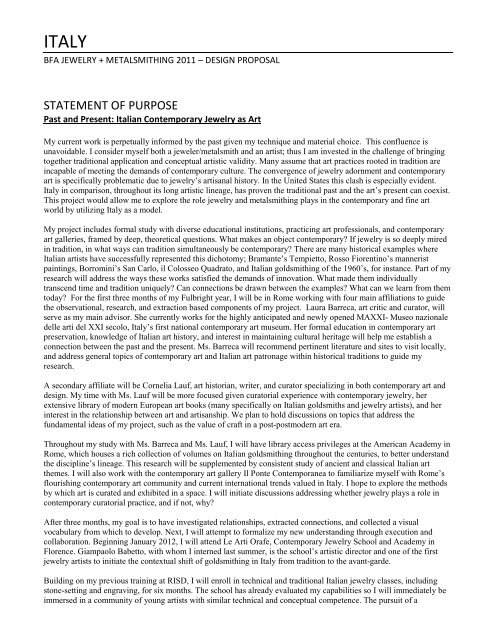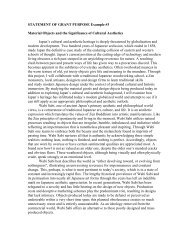STATEMENT OF PURPOSE - risd/careers
STATEMENT OF PURPOSE - risd/careers
STATEMENT OF PURPOSE - risd/careers
Create successful ePaper yourself
Turn your PDF publications into a flip-book with our unique Google optimized e-Paper software.
ITALY<br />
BFA JEWELRY + METALSMITHING 2011 – DESIGN PROPOSAL<br />
<strong>STATEMENT</strong> <strong>OF</strong> <strong>PURPOSE</strong><br />
Past and Present: Italian Contemporary Jewelry as Art<br />
My current work is perpetually informed by the past given my technique and material choice. This confluence is<br />
unavoidable. I consider myself both a jeweler/metalsmith and an artist; thus I am invested in the challenge of bringing<br />
together traditional application and conceptual artistic validity. Many assume that art practices rooted in tradition are<br />
incapable of meeting the demands of contemporary culture. The convergence of jewelry adornment and contemporary<br />
art is specifically problematic due to jewelry’s artisanal history. In the United States this clash is especially evident.<br />
Italy in comparison, throughout its long artistic lineage, has proven the traditional past and the art’s present can coexist.<br />
This project would allow me to explore the role jewelry and metalsmithing plays in the contemporary and fine art<br />
world by utilizing Italy as a model.<br />
My project includes formal study with diverse educational institutions, practicing art professionals, and contemporary<br />
art galleries, framed by deep, theoretical questions. What makes an object contemporary? If jewelry is so deeply mired<br />
in tradition, in what ways can tradition simultaneously be contemporary? There are many historical examples where<br />
Italian artists have successfully represented this dichotomy; Bramante’s Tempietto, Rosso Fiorentino’s mannerist<br />
paintings, Borromini’s San Carlo, il Colosseo Quadrato, and Italian goldsmithing of the 1960’s, for instance. Part of my<br />
research will address the ways these works satisfied the demands of innovation. What made them individually<br />
transcend time and tradition uniquely? Can connections be drawn between the examples? What can we learn from them<br />
today? For the first three months of my Fulbright year, I will be in Rome working with four main affiliations to guide<br />
the observational, research, and extraction based components of my project. Laura Barreca, art critic and curator, will<br />
serve as my main advisor. She currently works for the highly anticipated and newly opened MAXXI- Museo nazionale<br />
delle arti del XXI secolo, Italy’s first national contemporary art museum. Her formal education in contemporary art<br />
preservation, knowledge of Italian art history, and interest in maintaining cultural heritage will help me establish a<br />
connection between the past and the present. Ms. Barreca will recommend pertinent literature and sites to visit locally,<br />
and address general topics of contemporary art and Italian art patronage within historical traditions to guide my<br />
research.<br />
A secondary affiliate will be Cornelia Lauf, art historian, writer, and curator specializing in both contemporary art and<br />
design. My time with Ms. Lauf will be more focused given curatorial experience with contemporary jewelry, her<br />
extensive library of modern European art books (many specifically on Italian goldsmiths and jewelry artists), and her<br />
interest in the relationship between art and artisanship. We plan to hold discussions on topics that address the<br />
fundamental ideas of my project, such as the value of craft in a post-postmodern art era.<br />
Throughout my study with Ms. Barreca and Ms. Lauf, I will have library access privileges at the American Academy in<br />
Rome, which houses a rich collection of volumes on Italian goldsmithing throughout the centuries, to better understand<br />
the discipline’s lineage. This research will be supplemented by consistent study of ancient and classical Italian art<br />
themes. I will also work with the contemporary art gallery Il Ponte Contemporanea to familiarize myself with Rome’s<br />
flourishing contemporary art community and current international trends valued in Italy. I hope to explore the methods<br />
by which art is curated and exhibited in a space. I will initiate discussions addressing whether jewelry plays a role in<br />
contemporary curatorial practice, and if not, why?<br />
After three months, my goal is to have investigated relationships, extracted connections, and collected a visual<br />
vocabulary from which to develop. Next, I will attempt to formalize my new understanding through execution and<br />
collaboration. Beginning January 2012, I will attend Le Arti Orafe, Contemporary Jewelry School and Academy in<br />
Florence. Giampaolo Babetto, with whom I interned last summer, is the school’s artistic director and one of the first<br />
jewelry artists to initiate the contextual shift of goldsmithing in Italy from tradition to the avant-garde.<br />
Building on my previous training at RISD, I will enroll in technical and traditional Italian jewelry classes, including<br />
stone-setting and engraving, for six months. The school has already evaluated my capabilities so I will immediately be<br />
immersed in a community of young artists with similar technical and conceptual competence. The pursuit of a
traditional education bolsters my initial goal to be educated by the past, however it is imperative to note that the Le Arti<br />
Orafe emphasizes a conceptual and modern education as well. My own work will deal with this duality. I plan to<br />
synthesize the traditions of the past with contemporary idioms to create modern objects that speak to both worlds. Will<br />
my work be about the struggle goldsmithing has faced to legitimize itself as a valid form of art? Is the use of traditional<br />
techniques in innovative ways possible? If so, is it enough to contemporize the work?<br />
At Le Arti Orafe I will also work with Maria Cristina Bergesio, a traditional and contemporary jewelry expert and<br />
exhibition curator. With her help, I will further synthesize my studies and begin to think about jewelry’s existing place<br />
in the art gallery. This education will be supplemented by frequent trips to Padua, where Babetto was raised and<br />
educated, to visit contemporary jewelry galleries. I will also visit Florence’s Museo degli Argenti, which showcases an<br />
extensive collection of historical Italian jewels and contemporary goldwork. My intent is to question conventions of<br />
display that take jewelry out of its intended context. Is there a more appropriate way jewelry artists can showcase their<br />
work than the typical glass case? Can the viewer be invited to a new level of interaction?<br />
Although not yet an official affiliate, I have been in contact with Opera Rebis, a unique organization promoting art<br />
projects that emphasize partnership between young Italian and international artists. Opera Rebis is associated with<br />
another distinguished contemporary jewelry school in Florence, Alchimia. My hope is to unite the students of Le Arti<br />
Orafe, Alchimia and other young artists—to organize a jewelry exhibition that displays the conceptual and artistic<br />
nature of our work in a way that is apt and expressive. My past work at RISD, where I cofounded the school’s first<br />
student-run gallery, along with my collective experience thus far in Italy will make this a significant synthesis of my<br />
new ideas. The collaborative initiative will attempt to redefine the ways in which jewelry is shown—to push artistic<br />
approachability and expose our work to other art communities. If we believe jewelry is art and art can be jewelry, this<br />
event will have to manifest this idea. I want to create a new environment where history can meet innovation, the present<br />
can respect the past, and tradition can become contemporary.<br />
PERSONAL <strong>STATEMENT</strong><br />
Past and Present: Italian Contemporary Jewelry as Art<br />
I am sitting with my classmates listening to the director of Providence’s Jewelry Museum talk about the history of<br />
jewelry in America. While he speaks passionately of the trade, he makes frequent reference to industry—my first<br />
indication that we are on somewhat different pages. He speaks of jewelry in America’s short history in terms of a<br />
mass-market, and seems largely interested in innovative manufacturing trends. I have realized my resistance to this<br />
commercial mindset prior to this talk, but the distaste that he sparks in my artistic mind reaffirms my opposition.<br />
I turn my thoughts to Italy, were cultural ideals more closely relate to my values. I recall on a specific moment of my<br />
previous summer’s internship, where I spent two glorious weeks in the Italian countryside working for a man I can’t<br />
help but call my hero, Giampaolo Babetto. Babetto has a different soul than the man in front of me today. He embodies<br />
ideals exactly opposite to American trends in jewelry production; he values the unique hand-made object.<br />
I remember sitting across from Babetto in his studio on the second day of my two-week internship, sweating profusely.<br />
Was it the intolerable humidity of a hot July or my nerves that<br />
caused this reaction? Babetto had offered to help me fabricate a ring I had designed with his own work as inspiration. I<br />
was sawing circles out of a large sheet of silver that would have cost me an arm and a leg. I was surprised to find the<br />
routine task so incredibly difficult when performing it in front of a master… surely if I broke a saw blade this man<br />
would consider me a novice, undeserving to benefit from his decades of expertise and artistry!<br />
I had to channel his energy somehow. What better distraction than to think of Babetto’s own artistic influence on<br />
jewelry, goldsmithing to be precise, a practice so deeply rooted in Italian cultural history. Babetto is the second<br />
generation of the Padua School, a globally recognized lineage of jewelers that since the 1960’s have contributed to the<br />
conceptual repurposing of their discipline. This man showed the international jewelry community and the<br />
encompassing world of fine art that contemporary jewelry innovation could manifest in traditional techniques. Being<br />
“contemporary” no longer required high-production rates, easy assemblage, or unconventional materials like plastic.<br />
As I thought of Babetto’s legacy, I relaxed my shoulders and took a deep breath. I remembered I was using his tools,<br />
extensions of his own hands. His mastery of material somehow managed to calm me, and I continued to saw without
eaking a single blade. Life has a funny way of piecing together seemingly unrelated experiences. Looking back now<br />
I realize my time with Babetto harmonized the last twenty years of my cultural, artistic, and family life. From a young<br />
age my father’s incessant need for carbonara, a good Tuscan red, and a love for Caravaggio led my family on frequent<br />
trips to Italy made possible by my mother’s job as a flight attendant. I too was first drawn to Italy’s beauty, history, and<br />
endless amounts of prosciutto, but I had no idea my own artistic journey would pull me back so intimately.<br />
I tune in again to our lecturer. I know his paradigm is hard to transcend in an American context, but I also know I am<br />
already among a small community whose beliefs and ambitions align with mine. We see that jewelry can be more than<br />
commercial production, fashion trends, or handicraft—it possesses an intimacy of scale and a relationship to the body;<br />
it is a means for social engagement and a messenger from past to present. I believe these potentials have already been<br />
duly embraced in Italy. My goal is to immerse myself in this culture to better understand the feelings, the influences,<br />
and the history that made this artistic growth in jewelry possible.
















